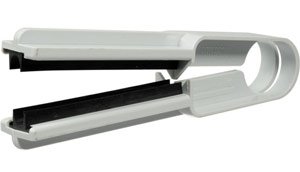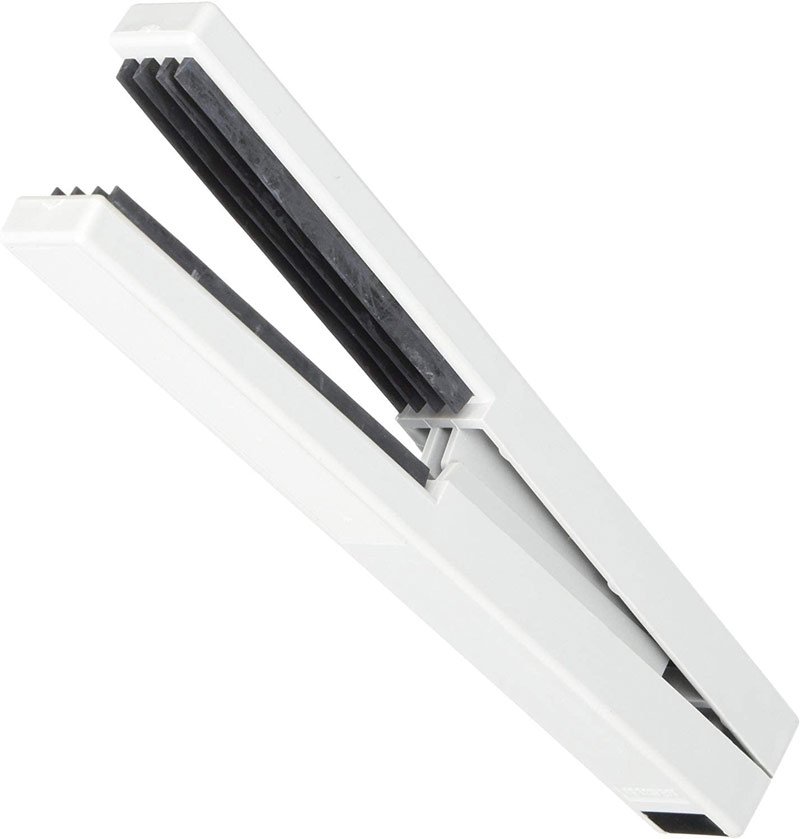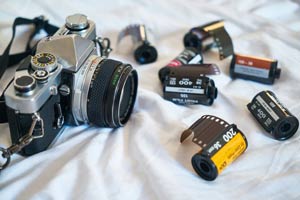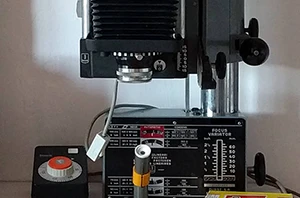What is a film squeegee?
A film squeegee, also called a film wiper, is a pair of tongs equipped with soft rubber blades or foam pads. Film is pulled between the blades to remove water from the surface after developing. Using a squeegee prevents water droplets from drying on the surface of the film which can cause spots, especially if using hard water for final rinse. Working much like a conventional window squeegee, the construction of the device allows it to wipe down both sides simultaneously.
How do you use a film squeegee?
A film squeegee is used as an optional last step of the film developing routine before the film is hung to dry. After washing is complete and any final rinses like wetting agents or stabilizers have been used the film can be squeegeed. Only use a squeegee on film with sufficently hardened emulsion. Pretty much all modern film emulsions are sufficently hard to handle being squeegeed.
Some classic films with older style emulsions, however, are a bit softer and can be more easily scratched. Such films, like Fomapan or some Fuji Neopans for example, can benefit from a hardening fixer to improve their resilience. Certain developers may also make certain emulsions more scratch prone. Finally, temperature also affects emulsion hardness, so for high temperature processes like C41 or E6 it’s best to keep your final rinse temperatures closer to room temperature.
Proper procedure is needed to minimize the risk of scratching the film. For any crucial jobs, it’s always best to do a test with your particular film, chemicals and tools to run through the procedure and make sure everything is working properly. Both the film and the squeegee should be perfectly clean. Even a tiny spect of dust or dirt on the rubber blades can leave an ugly scratch along the entire lenght of the film. To avoid this, thoroughly wash the squeegee under running water immediately before use and keep it in a sealed plastic bag when storing it.
To reduce friction and the risk of damage, make sure both the rubber blades and the film are still dripping wet. Using wetting agent in your final rinse would further lubricate the works and reduce the chance of dragging marks. For best results, wet the squeegee blades with the final rinse solution (wetting agent solution for black and white or stabilizer for color). Gently clamp the film between the rubber blades, and steadily pull the film through once. Exert just enough pressure on the tongs to keep them shut. Do not clamp on the squeegee forcefully, as it will only increase friction and the chances of scoring the emulsion. Do not run the film throug a second time, this is just asking for trouble.
Film squeegee maintenance
Most film squeegees have replaceable rubber blades. Keep an eye on yours, especially if you got the squeegee second hand. If you notice them getting harder or damaged do replace them. It is important for the rubber touchng the film to be as soft and pliable as possible to avoid damage.
If the blades are getting hard and are non-replaceable (or no replacements are available) you can try to restore them with a rubber revitalization product. We’ve had good luck with 303 Aerospace Protectant. If you do go down this road, make sure you clean the blades thoroughly after treatment to avoid leavng residue on the film later on.
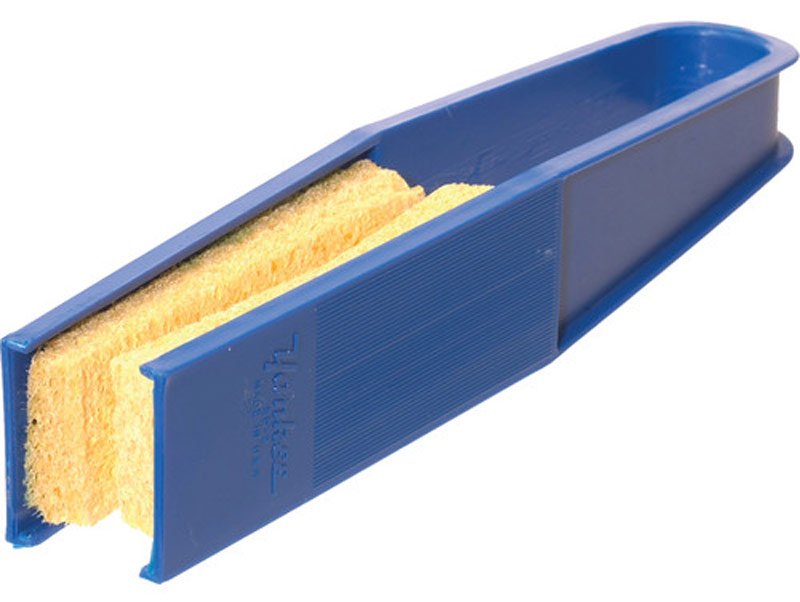
Do you need a film squeegee?
Squeeging film is a very controversial topic among film photographers that develop their own film. While some people swear by it, others would not touch their freshly developed film with anything. For every doomsayer preaching that squeegees are the devil incarnate, there’s somebody that has been using the same squeegee for 30 years with nary a scratch. In the end, it’s a personal preference.
Whether or not you need to squeegee your film depends on your particular process, the quality of water that you use, the film emulsion and chemicals and so on. You might be fine not using one for years, until you stumble upon that one film type or that new wetting agent that just needs to be wiped to dry properly. This is why, if you are serious about your darkroom work, a squeegee might be worth adding to your kit. Also check our darkroom buying guide for more ideas about useful kit.
Which one?
The Paterson 211 pictured above is one of the most popular models out there. It has soft rubber blades and is wide enough to handle 35mm and 120 film. For sheet film like 5×4, 5×7 and 8×10 the larger Paterson 255 print squeegee can be used. The 255 also serves double duty as one of the four Boba Fett’s shin tools in the Star Wars movies, as the actual squeegee was used as a prop while filming.
The Kaiser Film Wiper is another popular model. It comes with 70mm long rubber blades and like the Paterson 211 is best used for 35mm and 120 films. Compared to the two on the Paterson, the Kaiser model has four ridges on either blade. In theory, this would provide more even pressure on the film and higher effectiveness, although both models are reported to work equally well.
Another approach to film squeegees, the Yankee Film Squeegee, uses non-replaceable cellulose sponge instead of rubber for it’s blades. Reports on the effectiveness of the sponge squeegee are mixed. By their very nature, sponges retain dust and dirt much easier than rubber blades, and their washing is much more difficult. The consensus is that a well maintained rubber bladed model is safer and more effective.
What are film squeegee alternatives?
Basically, the final step of film development is all about preventing water spots. Whether you do that by squeeging or another approach is up to you. If you decide a squeegee is a bit too invasive for you, you can try some of the other options first.
Contactless
Going to the root of the problem, water spots appear once droplets of water with impurities of them are left to dry on the film surface. The squeegee deals with this by mechanically removing the water drops but there are other ways to go about this. A wetting agent like Kodak Photo-flo breaks the surface tension of water, allowing it to drain from the film. In theory, you can just rinse the film in the wetting agent and hang it to dry without any further interventions. This works better for some than others and like squeegeeing, wetting agents have their proponents and detractors.
Another avenue to pursue is to remove all impurities from the film’s final rinse by using pure distilled water instead of a wetting agent. This way, even if droplets do remain on the film surface, they contain no impurities to make spots once they dry. A sound method if you have distilled water handy, it’s the one we prefer here at Lens Notes when developing black and white film. For color it’s a bit more complicated, as a final rinse with distilled water goes against the manufacturers’ recommendations. For C41 and E6 processes, the final rinse to touch the film is supposed to be a dedicated stabilizer solution. In this instance, you have to either rely on the wetting agent contained within the stabilizer, or squeegee.
Squeegee without a squeegee
Finally, between the school of squeeging and the school of no-touch there is also a middle way of people squeeging their films without using actual squeegees. A popular option is to use your index and middle finger as a squeegee and run the wet film between them. Obviously, this approach can work with 35mm and 120 film but not large format film (unless you have exceptionally long fingers).
As an improvement to this method, some people use clean lint-free wipes like Kimwipes, microfiber towels or photo grade sponges to wipe the wet film down. We’ve found mixed results here, and the chance of catching a piece of grit and ruining your negatives grow exponentially when you introduce such variables.

